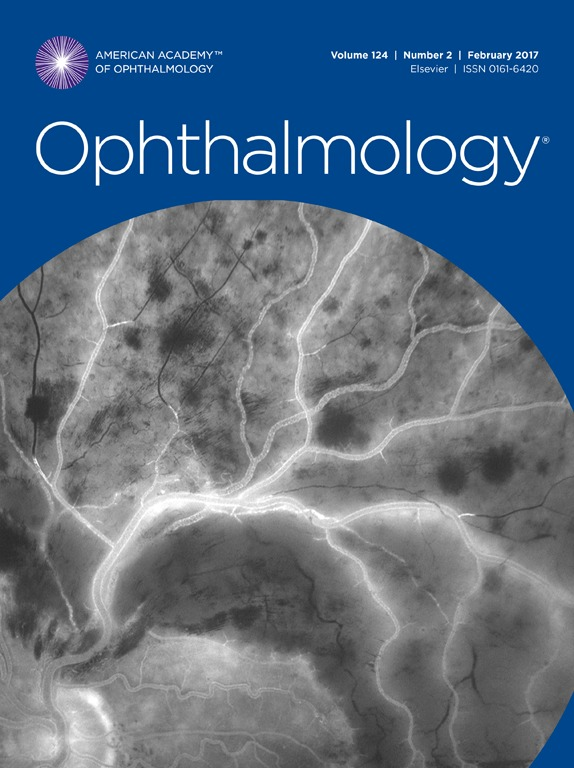Phase 1 Study of JNJ-81201887 Gene Therapy in Geographic Atrophy Secondary to Age-Related Macular Degeneration
IF 13.1
1区 医学
Q1 OPHTHALMOLOGY
引用次数: 0
Abstract
Purpose
To evaluate the safety and tolerability of a single intravitreal injection of JNJ-81201887 (JNJ-1887) in patients with geographic atrophy (GA) secondary to advanced dry age-related macular degeneration (AMD).
Design
Phase 1, open-label, single-center, first-in-human clinical study.
Participants
Adult patients (≥50 years of age) with GA secondary to AMD in the study-treated eye (treated eye) with Snellen best-corrected visual acuity of 20/200 or worse in the treated eye (20/80 or worse after the first 3 patients), a total GA lesion size between 5 and 20 mm2 (2–8 disc area), and best-corrected visual acuity of 20/800 or better in fellow, nontreated eye were included.
Methods
Patients (n = 17) were enrolled sequentially into low-dose (3.56 × 1010 viral genome/eye; n = 3), intermediate-dose (1.07 × 1011 viral genome/eye; n = 3), and high-dose (3.56 × 1011 viral genome/eye; n = 11) cohorts without steroid prophylaxis and assessed for safety and tolerability over 24 months.
Main Outcome Measures
Safety and tolerability outcomes included assessment of ocular and nonocular treatment-emergent adverse events (AEs) over 24 months. Secondary outcomes included GA lesion size and growth rate.
Results
Baseline patient characteristics were consistent with the disease under study, and all enrolled patients demonstrated foveal center–involved GA. JNJ-81201887 was well-tolerated across all cohorts, with no dose-limiting AEs. No serious or systemic AEs related to study intervention occurred. Overall, 5 of 17 patients (29%) experienced 5 events of mild ocular inflammation related to study treatment; examination findings in all resolved, and AEs resolved in 4 of 5 patients after topical steroids or observation. One unresolved vitritis event, managed with observation, occurred in a patient with an unrelated fatal AE. No endophthalmitis or new-onset choroidal neovascularization was reported. Geographic atrophy lesion growth rate was similar among all cohorts over 24 months. For treated eyes in the high-dose cohort, GA lesion growth rate showed continued decline through 24 months, with a reduction in mean square root lesion growth from 0.211 mm at months 0 through 6 to 0.056 mm at months 18 through 24.
Conclusions
All 3 studied doses of JNJ-1887 showed a manageable safety profile through 24 months of follow-up. Further investigation of JNJ-1887 for the treatment of GA is warranted.
Financial Disclosure(s)
Proprietary or commercial disclosure may be found in the Footnotes and Disclosures at the end of this article.
JNJ-81201887 基因疗法治疗继发于老年性黄斑变性的地理萎缩的 1 期研究。
目的评估晚期干性年龄相关性黄斑变性(AMD)继发地理萎缩(GA)患者单次玻璃体内注射 JNJ-81201887 (JNJ-1887)的安全性和耐受性:设计:1期、开放标签、单中心、首次人体临床研究:受试者:年龄≥50 岁,研究对象治疗眼(治疗眼)继发于 AMD 的成人 GA 患者,治疗眼的最佳矫正视力(BCVA)斯奈伦等效视力为 20/200 或更差(前 3 位患者为 20/80 或更差),GA 病变总面积在 5 至 20 平方毫米(2-8 圆盘面积)之间,同侧非治疗眼的 BCVA 为 20/800 或更佳:将患者(17 人)依次纳入低剂量组(3.56×1010 病毒基因组 [vg]/眼;3 人)、中剂量组(1.07×1011 vg/眼;3 人)和高剂量组(3.56×1011 vg/眼;11 人),不使用类固醇预防,并在 24 个月内对安全性和耐受性进行评估:安全性和耐受性结果包括对 24 个月内眼部和非眼部治疗引发的不良事件(AEs)进行评估。次要结果包括GA病变大小和生长率:结果:患者的基线特征与研究中的疾病一致,所有入组患者都患有眼窝中心受累的GA。所有组群对 JNJ-1887 的耐受性良好,没有出现剂量限制性 AE。没有出现与研究干预相关的严重或全身性 AE。总体而言,5/17(29%)名患者经历了 6 次与研究治疗相关的轻度眼部炎症事件;所有患者的检查结果均已缓解,5 名患者中有 4 名患者在使用局部类固醇或观察后,AEs 均已缓解。一名患者的玻璃体炎症未得到缓解,但通过观察得到了控制,该患者还出现了与此无关的致命性 AE。没有眼内炎或新发脉络膜新生血管的报道。在 24 个月内,所有组别中的 GA 病变增长率相似。对于高剂量队列中接受治疗的眼睛,GA病变增长率在24个月内持续下降,平均平方根病变增长率从0-6个月的0.211毫米降至18-24个月的0.056毫米:结论:所研究的三种剂量的 JNJ-1887 在 24 个月的随访期间都具有可控的安全性。有必要进一步研究 JNJ-1887 治疗 GA 的效果。
本文章由计算机程序翻译,如有差异,请以英文原文为准。
求助全文
约1分钟内获得全文
求助全文
来源期刊

Ophthalmology
医学-眼科学
CiteScore
22.30
自引率
3.60%
发文量
412
审稿时长
18 days
期刊介绍:
The journal Ophthalmology, from the American Academy of Ophthalmology, contributes to society by publishing research in clinical and basic science related to vision.It upholds excellence through unbiased peer-review, fostering innovation, promoting discovery, and encouraging lifelong learning.
 求助内容:
求助内容: 应助结果提醒方式:
应助结果提醒方式:


